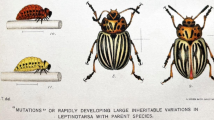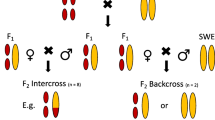Abstract
Frequency-dependent selection may be accounted for, in ecological terms, by the differential effectiveness of alternative genotypes in exploiting limiting environmental resources. Differentiation in resource exploitation among genotypes implies in turn that a mix of genotypes may exploit more fully the resources than a genetically uniform population, a phenomenon called ‘overcompensation’ Experiments designed to test for overcompensation whow that highly polymorphic populations can support larger numbers of individuals per food unit than less polymorphic populations. This difference cannot be attributed to the level of individual heterozygosity, which is the same in both types of populations.
Similar content being viewed by others
References
Ayala, F. J., 1968. Genotype, environment, and population numbers. Science 162: 1453–1459.
Ayala, F. J., 1971. Competition between species: Frequency dependence. Science 171: 820–824.
Ayala, F. J., 1972. Competition between species. Amer. Scientist 60: 348–357.
Ayala, F. J. & Campbell, C. A., 1974. Frequency-dependent selection. A. Rev. Ecol. Syst. 5: 115–138.
Clarke, B. C. & Partridge, L. (eds), 1988. Frequency-Dependent Selection. The Royal Society, London.
Fisher, R. A., 1930. The Genetical Theory of Natural Selection. Reprinted by Dover Publications, New York.
Kojima, K., 1971. Is there a constant fitness value for a given genotype? No! Evolution 25: 281–285.
Levene, H., Pavlovsky, O. & Dobzhansky, Th., 1954. Interaction of the adaptive values in polymorphic experimental populations of Drosophila pseudoobscura. Evolution 8: 335–349.
Levins, R., 1965. Theory of fitness in a heterogeneous environment. V. Optimal genetic systems. Genetics 52: 891–904.
Peng, T.-X., Moya, A. & Ayala, F. J., 1990. Two modes of balancing selection in Drosophila melanogaster: Overcompensation and overdominance (submitted).
Petit, C., 1951. Le rôle de l'isolement sexuel dans l'évolution des populations de Drosophila melanogaster. Bull. biol. Fr. Belg. 85: 392–418.
Tošić, M. & Ayala, F. J., 1980. ‘Overcompensation’ at an enzyme locus in Drosophila pseudoobscura. Genet. Res. Camb. 36: 57–67.
Author information
Authors and Affiliations
Rights and permissions
About this article
Cite this article
Milosevié, M., Moya, A. & Ayala, F.J. Overcompensation as a mechanism for maintaining polymorphism: egg-to-adult viability in Drosophila . Genetica 82, 183–187 (1990). https://doi.org/10.1007/BF00056361
Received:
Accepted:
Issue Date:
DOI: https://doi.org/10.1007/BF00056361




